Pratt & Whitney Wasp Junior (R-985)
Compiled by Kimble D. McCutcheon
Published 13 Apr 2020
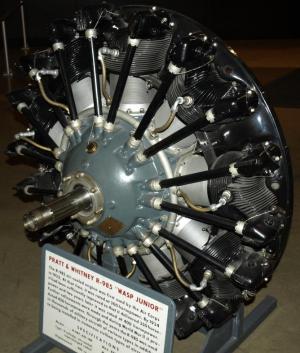
Pratt & Whitney Wasp Junior (John Fowler) |
The Pratt & Whitney Wasp Junior (R-985) was a derivative of the earlier Wasp, but intended for a smaller aircraft class requiring between 300 and 450 hp.
During the 1930s, Wasp Juniors powered numerous single-engine executive transports built by Beechcraft, Bellanca, Howard, Spartain, Stinson, and Waco. It powered the Beechcraft Model 18 and Lockheed Electra twins, along with Grumman and Sikorsky amphibians. The engine was widely used during WWII for training aircraft and postwar in agricultural spray planes. It also was used in helicopters.
P&W and its licensees produced a total of 39,037 Wasp Juniors between 1929 and 1953. |
Wasp Junior Description
Type = 9-Cylinder Air-Cooled Radial
Bore = 5.188" Stroke = 5 .188" Displacement = 986.7 in³
Cylinders are built up of cast aluminum heads with integral valve mechanism housings, screwed and shrunk onto forged chrome-molybdenum steel barrels having integral fins. Individually removable baffles provide uniform cooling air distribution under severe flight conditions.
Pistons are machined from aluminum alloy forgings. The piston crown underside is ribbed for strength and increased cooling area. Three compression rings, two dual oil control rings and one oil scraper ring comprise the ring pack.
The master rod has eight "I" section articulated rods attached by knuckle pins. These articulated rods are fitted with bronze bushings in both knuckle pin and piston pin ends. The master rod has a plain lead-bronze crankpin bearing.
The single-throw, two-piece crankshaft is machined from forged alloy steel. The crankshaft is supported by three bearings, one roller bearing on each side of power section and a ball thrust bearing in nose section.
The crankcase nose section is a hemispherical magnesium casting, housing the cam operating mechanism and valve tappets.
The crankcase main section consists of two similar forged from aluminum alloy sections, machined together, divided on the cylinder center line and united by through bolts and cylinder flanges.
The crankcase blower section contains the centrifugal supercharger and engine mounting lugs.
The crankcase accessory section carries all accessories and has integrally cast vanes in the carburetor intake elbow for balanced fuel mixture distribution.
The valve gear is completely enclosed. A cam drum, rotating opposite the crankshaft direction at one-eighth crankshaft speed, drives overhead valves through tappets, push rods and rocker arms.
The induction system consists of a Stromberg self-priming carburetor with idle cutoff, primer tubing and mixture distributor. Mixture is fed from the carburetor through an intake elbow to the supercharger and blower section, which increases its pressure. Tangential intake pipes convey the compressed mixture to the cylinders.
The supercharger impeller is attached to an impeller shaft coaxial with the crankshaft and driven through a spring coupling mounted inside the crankshaft gear.
The ignition system consists of two Scintilla magnetos located on the accessory section, each independently firing spark plugs in all nine cylinders. Front and rear Pratt & Whitney type radio-shielded ignition manifolds provide short leads to each spark plug lead.
Forced lubrication is provided by a gear type pump in the rear section. Oil is passed through blower section, then through the lower part of the power section above the sump into a separate line in the nose section to the propeller control valve. Pressure oil from the nose is led through distributing grooves around the tappets, to metering ports, thereby automatically lubricating push rods and valve gear under constant pressure. The master rod bearing, knuckle pin bushings, cam, and cam gear are all force-lubricated by pressure oil. Accessory shafts and supercharger gearing are lubricated by drilled passages from the rear section oil strainer chamber and an oil jet in the main oil feed line. All other parts are lubricated by mist or spray from pressure-oiled parts.
Accessory drives, grouped in the rear section, are driven by three lay shafts extending entirely through the blower and rear sections. Each shaft carries a spur gear at its forward end, which engages the drive gear attached to rear of crankshaft. The upper shaft provides drives for starter and generator. Each of two lower shafts drives one magneto through an adjustable coupling. Four vertical drive shafts, each driven by a bevel gear, power various types of accessory pumps or gun synchronizers. Two tachometer drives, projecting outward from the rear case, are driven through worm gears at right angles to the vertical shafts, The lower shafts, driven from the same bevel gear, drive the oil pump on the right and the fuel pump on the left. A third bevel gear on the left side of the engine is suitable for driving a vacuum or hydraulic pump.
Wasp Junior Parts
 |
 |
 |
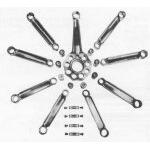 |
 |
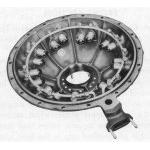 |
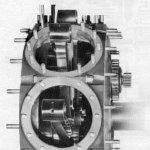 |
| Wasp Junior |
Cylinder |
Piston |
Rods |
Crankshaft |
Crankcase Nose Section |
Crankcase Main Section |
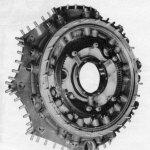 |
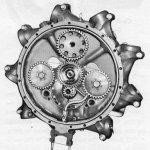 |
 |
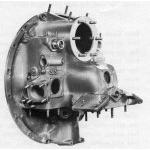 |
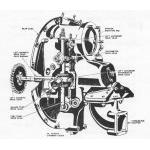 |
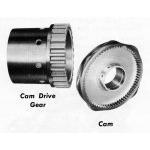 |
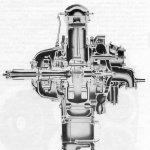 |
| Main Section Front |
Blower Section |
Supercharger Gears |
Accessory Section |
Accessory Drives |
Cam and Cam Drive |
Cutaway |














